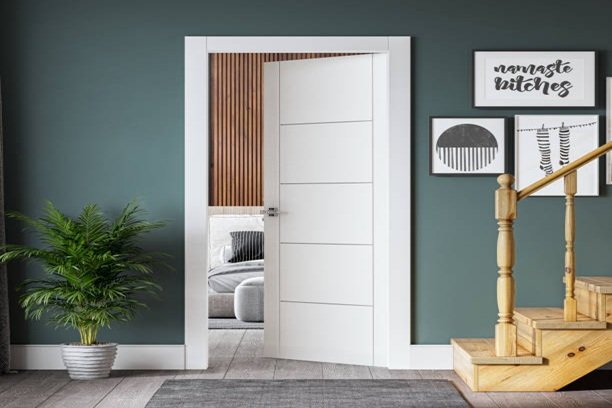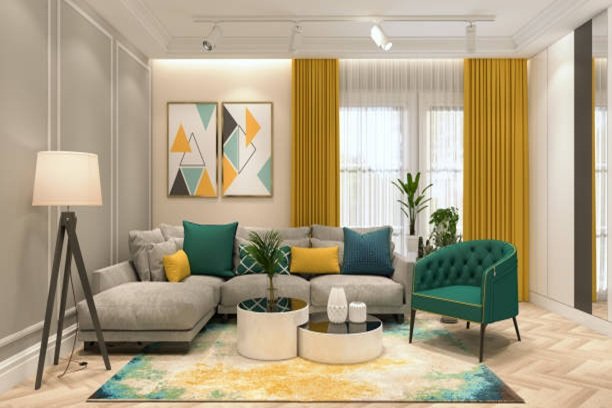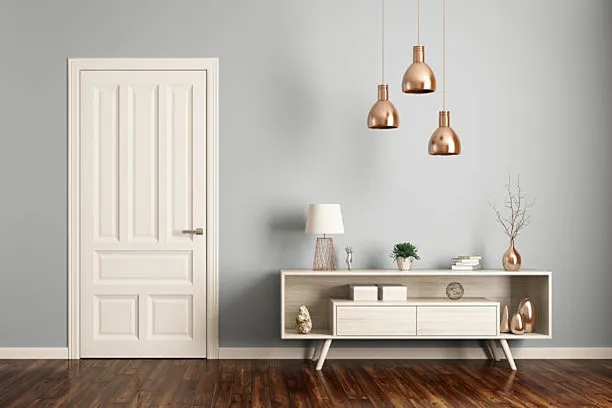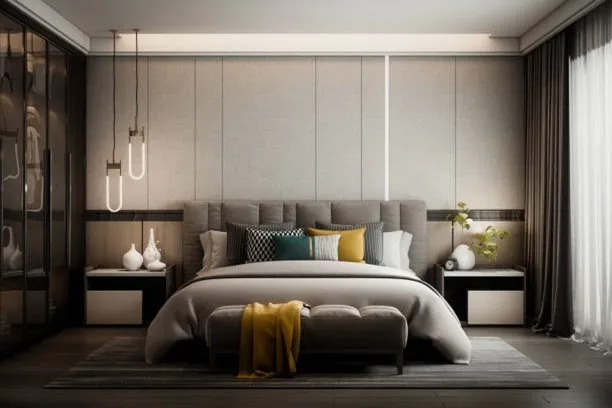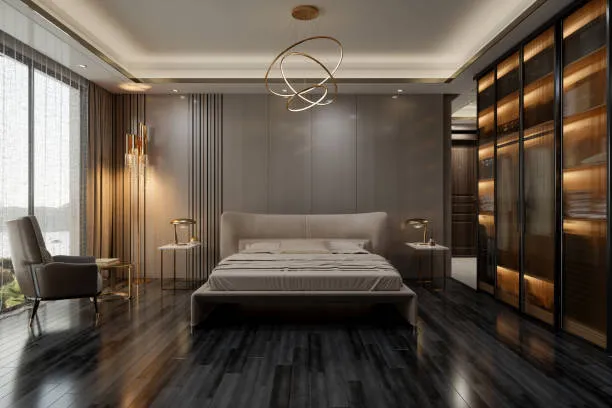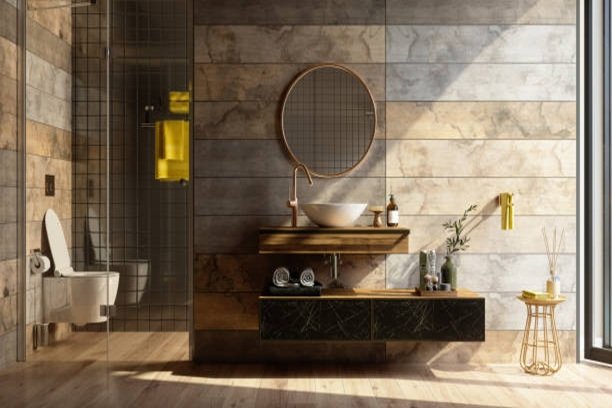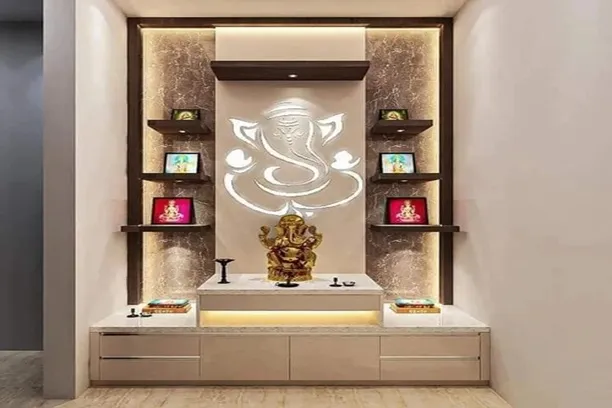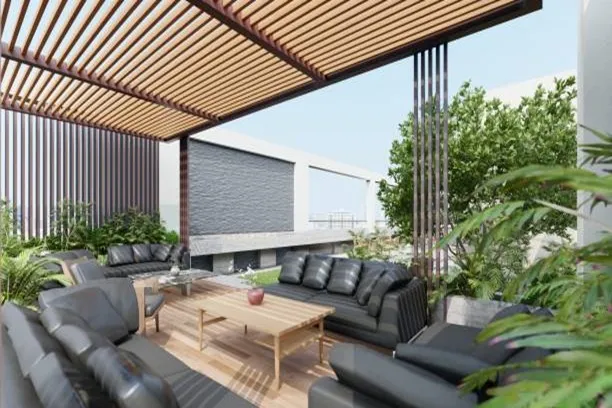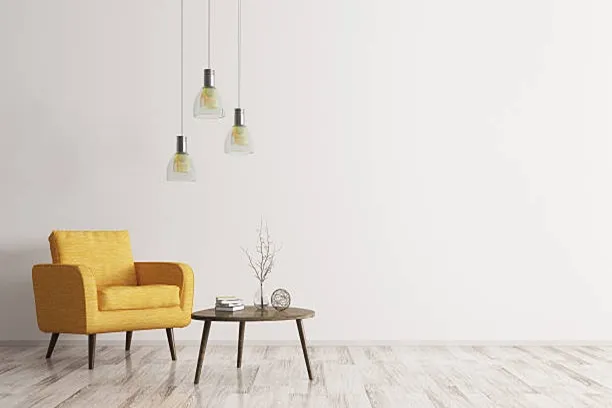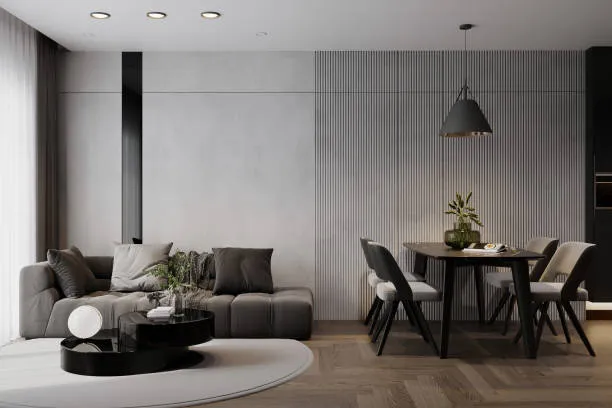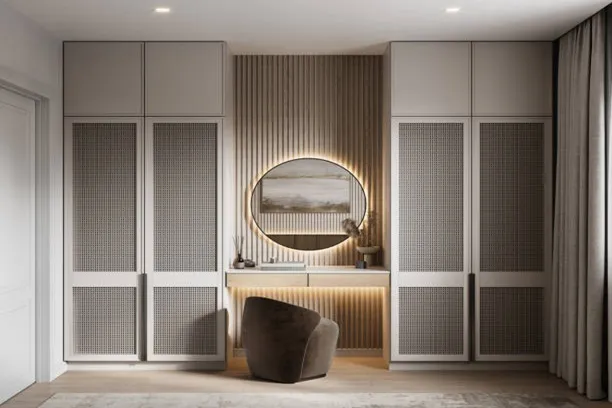Table of Contents
The presence of a mandir within a home is a nod to tradition. It is a quiet assertion of sanctity amidst the ordinary. It marks a deliberate space where the spiritual and the domestic converge, which invites stillness into the everyday. Thoughtfully executed, a mandir design becomes a symbolic expression of personal faith, cultural continuity, and spatial mindfulness. A mandir for home serves as a metaphysical anchor, and offers continuity in an age defined by change, and lending a sense of order, intention, and inwardness to one’s living environment.
As architecture and interior design increasingly reflect modern sensibilities, the notion of a pooja mandir for home has undergone a graceful transformation. Contemporary homeowners no longer view the sacred as separate from the aesthetic. Instead, they seek mandir designs that harmonise devotion with design, tradition with innovation.
This evolving dialogue between the sacred and the spatial has given rise to diverse expressions in home temple design. In the sections ahead, we explore the latest directions in designing a temple for home, ideas that do not merely house deities but honour presence, purpose, and poise in the heart of modern living.
As architecture and interior design increasingly reflect modern sensibilities, the notion of a pooja mandir for home has undergone a graceful transformation. Contemporary homeowners no longer view the sacred as separate from the aesthetic. Instead, they seek mandir designs that harmonise devotion with design, tradition with innovation.
This evolving dialogue between the sacred and the spatial has given rise to diverse expressions in home temple design. In the sections ahead, we explore the latest directions in designing a temple for home, ideas that do not merely house deities but honour presence, purpose, and poise in the heart of modern living.
Mandir Designs for Home
1. Wall mounted pooja mandir with doors
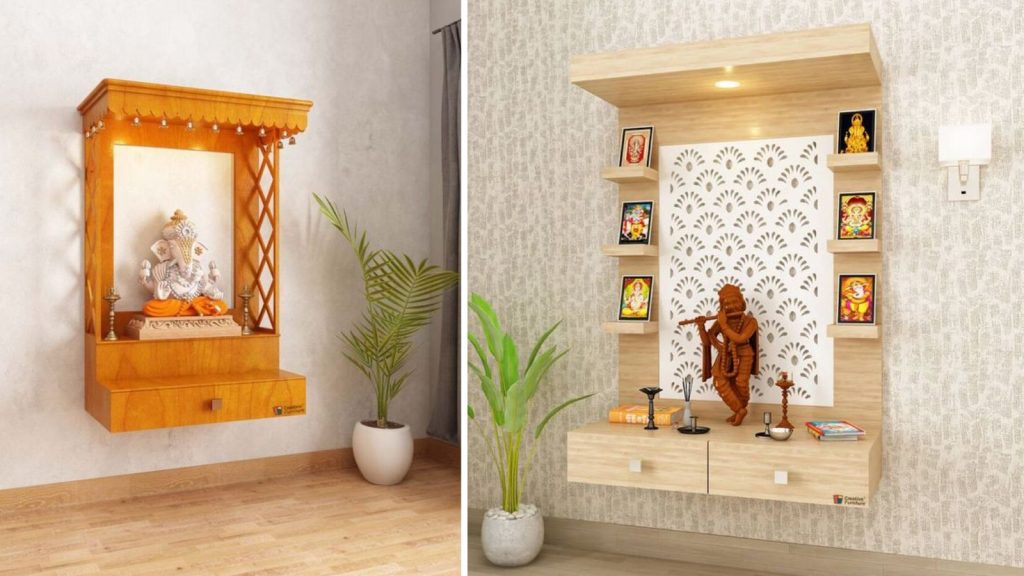
- Wall-mounted mandirs with doors are a blessing for urban homes. Urban homes are usually limited in space, with open layouts and multifunctional areas. They save floor area and neatly define a spiritual zone, even in small apartments.
- The addition of doors helps maintain sanctity. You can keep the mandir closed when not in use, which preserves its sacred energy and offers privacy to your prayer space.
- These mandirs mix tradition and modern aesthetics together. Ranging from wooden jali doors to sophisticated MDF designs with LED lighting, they complement a variety of home interiors beautifully.
- Doors help protect the idols and pooja items from dust, especially in homes close to main roads or in metro cities. Plus, most units come with a small shelf or drawer for storing incense sticks, matchboxes, or camphor.
- Since wall-mounted units can be positioned as per your layout, you can easily align them with Vastu directions. Typically, the northeast corner, and you don’t need to worry about floor-level constraints.
- You can customise the material and finish, such as wood, marble-texture laminate, or even glass. This matches the overall mood of your living space.
2. Corner mandir design
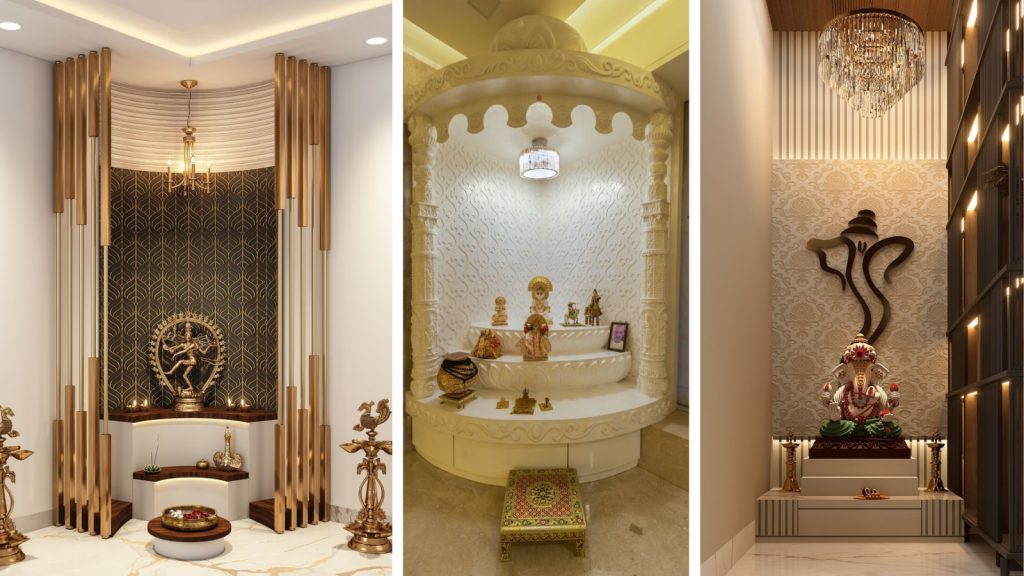
- By making use of an underutilised corner in the living room, hallway, or in a bedroom, you can create a peaceful pooja zone without disturbing the flow of the room.
- These mandirs often follow an L-shaped or triangular layout that fits snugly into the corner. This makes the space feel purposeful instead of wasted. In fact, some designs extend vertically with open shelves or wall-mounted panels to maximise storage and spiritual display.
- Corner mandirs come in a variety of styles to suit traditional and contemporary interiors. You can personalise them with brass bells, framed mantras, or soft LED lighting to elevate the look.
- They’re especially useful for rented apartments or smaller flats where a separate pooja room isn’t possible. A well-designed corner mandir helps you retain that spiritual connection using only minimal space.
- Many corner mandirs include base cabinets or floating drawers for storing essentials like incense sticks, matchboxes, prayer books, and diyas. It keeps everything tucked away neatly yet within reach.
- A corner mandir can be just as auspicious as a full-fledged temple space in larger homes with proper alignment, like placing the mandir in the northeast or east-facing corner.
3. Standing pooja room
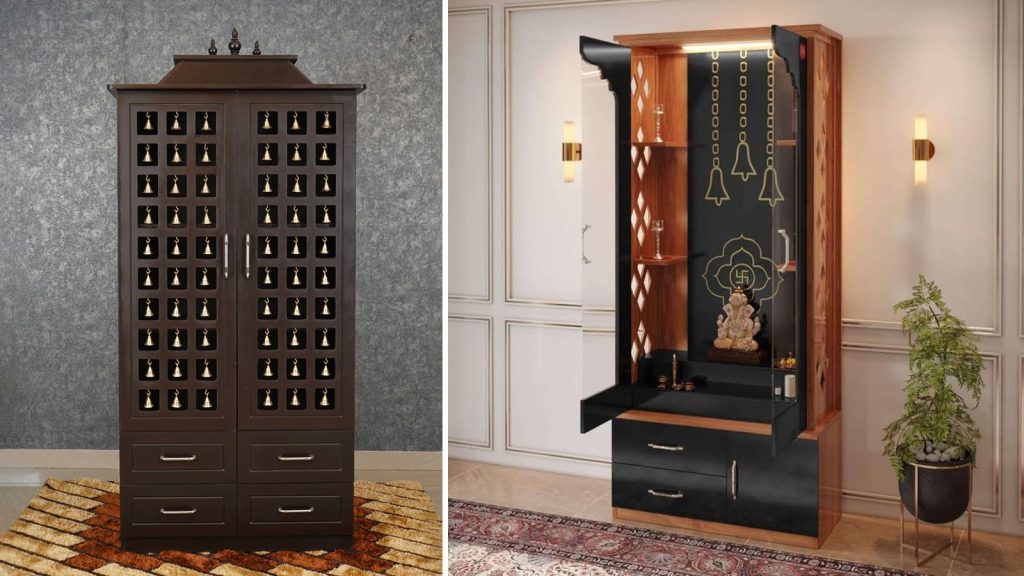
- A standing pooja room is a compact spiritual cabinet that gives you the feel of a full-fledged temple. And this doesn’t need an entire room space. It’s a vertical, self-contained unit that usually stands independently in your living or dining area.
- These are perfect for people who want a dedicated space for prayer but don’t have an extra room to spare. If you live in a 2BHK flat or a sung studio, a standing mandir helps you set up a beautiful pooja corner with minimal disruption to your existing layout.
- Most standing pooja rooms come with storage built into the base. That means you’ll always have space to keep incense sticks, oil bottles, pooja thalis, and prayer books neatly organised.
- Design-wise, they’re super flexible. You’ll find everything from ornate wooden mandirs with domes and carved pillars to more minimal, contemporary styles in MDF, marble finish, or even glass. It really depends on your taste and the overall theme of your home.
- Many of these units come with doors. Some come with jaali work or frosted panels too. So you can close the mandir after rituals and keep the space looking neat and sacred. It also offers a sense of privacy, especially in open-plan homes.
- You can place a standing mandir wherever vastu allows. The best corner would be the northeast corner, near the entryway, or even in a quiet corner of your living room. It’s practical, beautiful, and deeply personal.
4. Jali mandir design
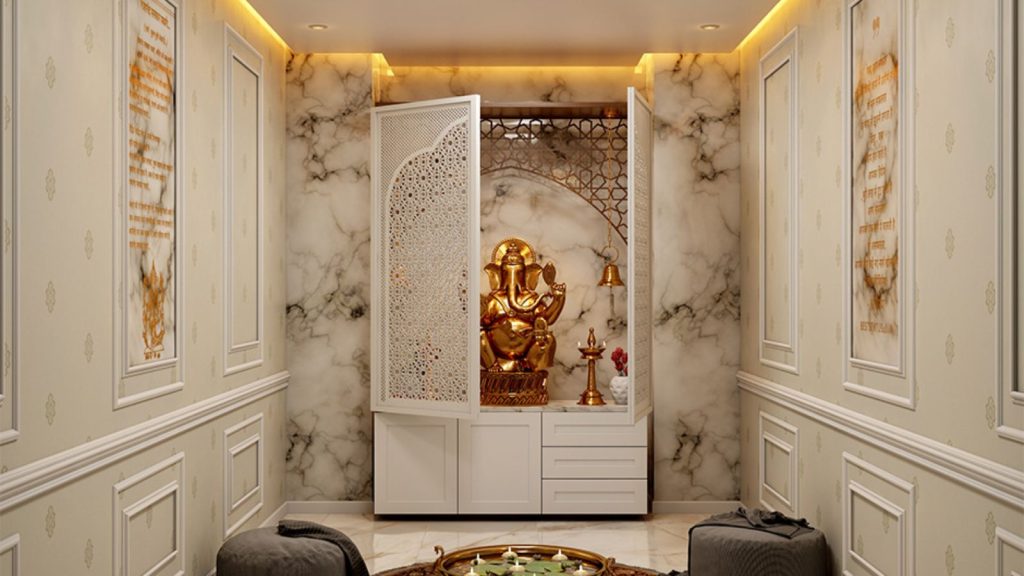
- Jali panels have intricate latticework screens. And these screens bring a soothing mix of light, air, and privacy to your mandir. They let soft sunlight filter through while readying a serene ambiance for prayer.
- Jali designs can be tailored to your home’s atmosphere when crafted from a range of materials like wood, MDF, marble, brass, steel, acrylic, or PVC.
- Motifs have their importance. A floral pattern comes with a natural, gentle charm, geometric or Shree Yantra shapes give a touch of sacred order, and religious symbols like Om, Swastika, or Radha-Krishna make the mandir deeply spiritual.
- Jali helps with passive temperature control. It acts as a natural ventilator and reduces glare.
- You can get creative and jut out jail panels, as they can frame a beautiful wall niche. Jali doors with bells invite a delightful sensory touch, or a full jali backdrop can visually elevate a floating or floor-mounted mandir unit.
- A thoughtful jali design keeps your pooja area organised and discreet. When closed, the lattice hides clutter and offers quiet focus. When it is open, it highlights your idols and pooja setup with grace.
5. Portable Pooja Unit
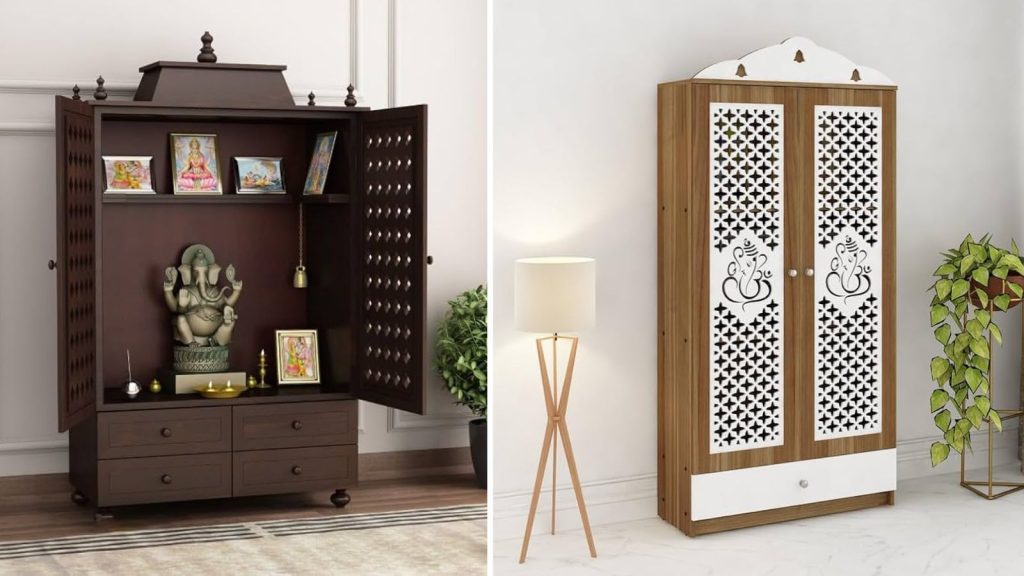
- Portable pooja units offer flexibility and mobility. They’re lightweight and compact. This makes it easy to relocate your mandir within different rooms of the house or even pack it up during festivals or moves.
- These units balance durability with aesthetic appeal. Because they are crafted from materials like wood (teak, Sheesham), fiber, or even marble. You can pick a style that complements traditional living rooms or minimalist interiors.
- They typically include built-in storage solutions, small drawers or shelves at the base, for organizing incense sticks, diya wicks, camphor, and other pooja essentials neatly. They keep everything ordered and organised.
- Many designs are foldable or collapsible, and allow you to tuck them away when not in use.
- Thanks to their compact form, portable mandirs fit almost anywhere. They can be easily placed in a living room corner, next to a window, or even on a balcony. And still being Vastu-friendly, as they’re easy to position toward northeast or east.
- Beyond convenience, these units offer personalized design touches. Many feature jali work, carved pillars, acrylic panels, or LED accent lighting. These features turn a simple movable structure into a sacred, visually appealing centerpiece.
6. Wooden Mandir Design for Home/ Wooden Temple for Home
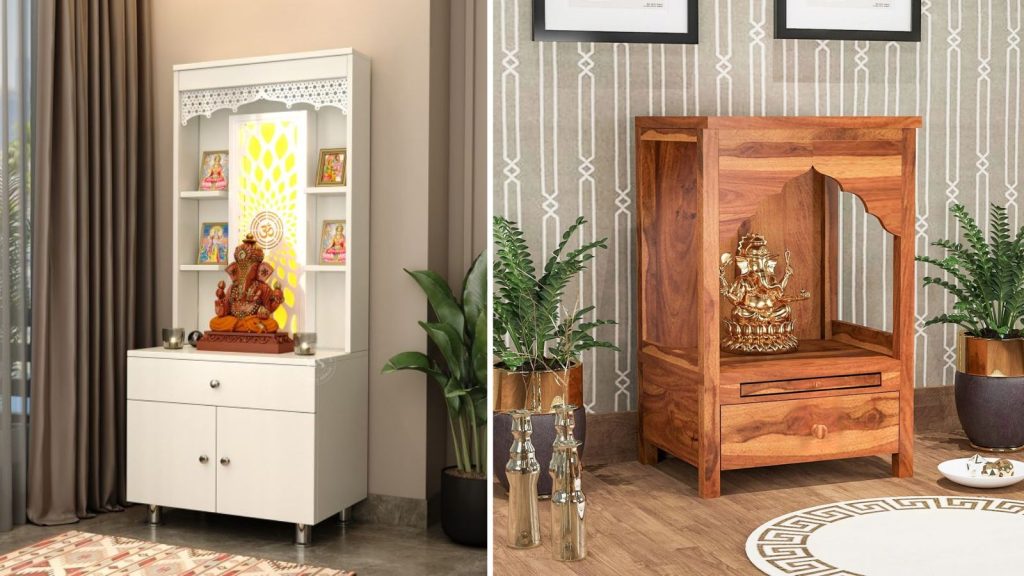
- Many wooden mandir designs embrace intricate carvings and domed roofs. They draw inspiration from traditional temple architecture. They are designed from quality woods like teak, rosewood, or sheesham. These mandirs bring peace, sophistication, and a hint of heritage to your prayer corner.
- A growing trend is integrated LED lighting. It is subtle backlighting or under-shelf LEDs that highlight the idols and carvings. It creates an intimate and serene atmosphere. These lights also lift up corners that lack natural sunlight.
- Floating wooden mandirs, mounted at eye-level, are popular for modern homes. They save floor space, ease cleaning underneath, and let you pray comfortably while standing.
- Jali work on wooden mandirs infuses beauty and function. Intricate lattice panels introduce visual elegance and gentle lighting effects, and also help with air circulation, like traditional temple screens.
- If you prefer a contemporary touch, minimalist wooden mandirs with glass or acrylic doors offer a polished look. Such designs gel with modern interiors and maintain spiritual reverence simultaneously.
7. Marble Temple for Home
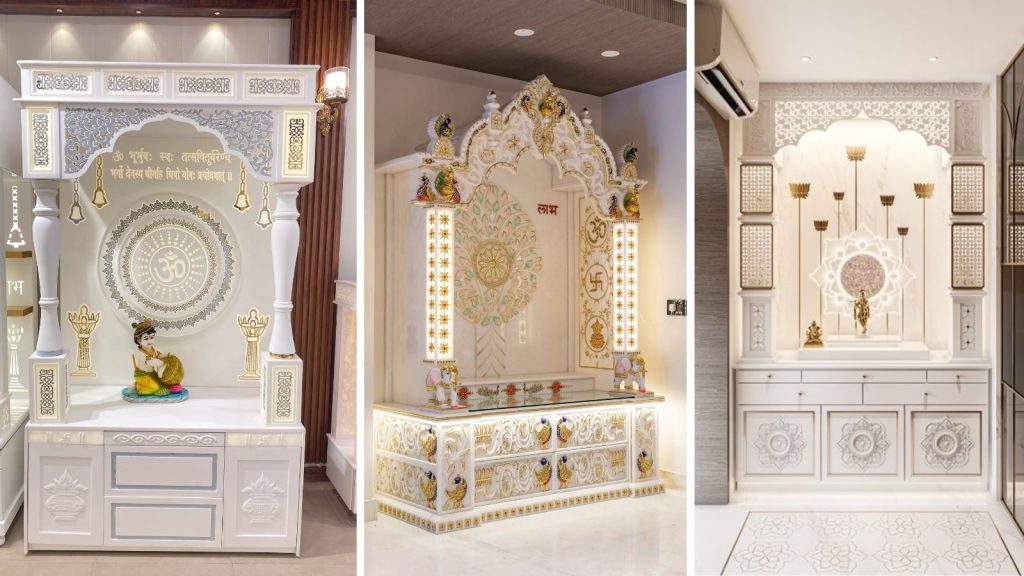
- Marble mandirs have natural veining and subtle sheen that gives a serene, refined atmosphere to any pooja space.
- Marble resists scratches, heat, and stains, and hence, they are known for durability. These mandirs can retain their pristine beauty for generations, and they are ideal for everyday use. A simple wiping and occasional sealing works.
- The spiritual purity of marble is hard to match. It’s cool, reflective surfaces are believed to foster calm and contemplation during worship. And the stone’s natural origin brings a grounding energy to the mandir.
- Design options abound from minimalist cabinets with clean lines to ornately carved pillars, inlays, jali work, and glass accents as well. You should choose a style that reflects your decorative quality.
- Smart design features like wall-mounted or floating marble mandirs save floor space and elevate your prayer area. Integrated backlighting highlights carvings beautifully and creates a tranquil evening ambiance.
- Marble mandirs are customizable. You can select from diverse color palettes, classic whites, warm beiges, bold blacks, or incorporate semi-precious inlays, carved motifs, or gold accents. This ensures the unit fits your home’s style and your spiritual expression.
8. Pooja Mandir Glass Door Design
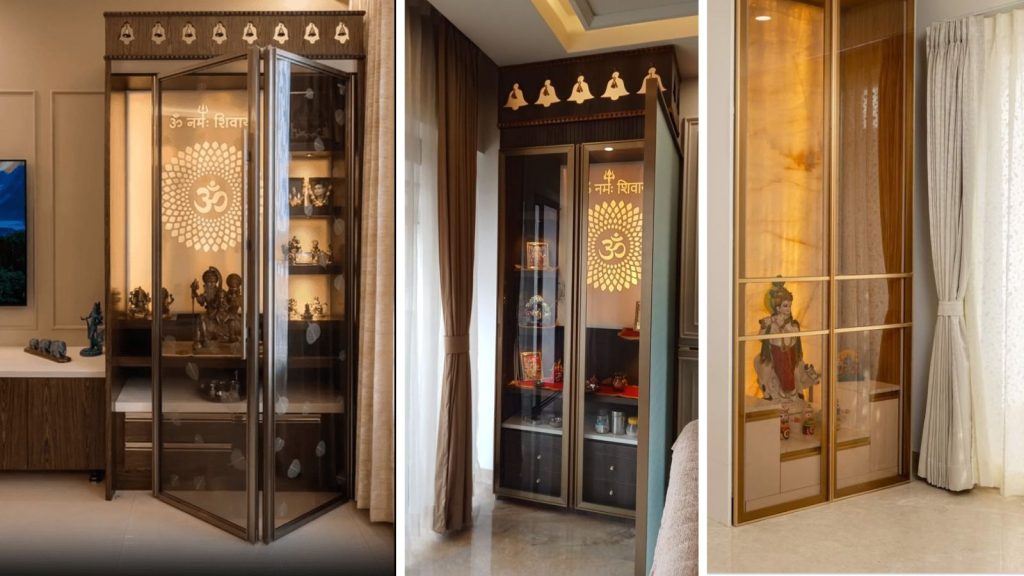
- Glass doors offer a clear view of your idols and decor. They softly filter ambient light into the space too. This transparency keeps the pooja area connected to the rest of your home, and still doesn’t compromise with its sacredness.
- Etched or patterned glass features lotus motifs, Sanskrit symbols, or geometric designs. It channels elegance and privacy while still allowing light to pass through. Acid-etched and frosted options mask the interior in a serene haze.
- Sliding or foldable glass doors are ideal for tight spaces, and offer smooth access without swinging clearance. They’re a smooth-looking space-saver for compact homes.
- When you combine wood or metal frames with glass, it leads to a warm and structurally sturdy contrast. Dark wood frames, in particular, balance the modern transparency with classic richness.
- Stained or coloured glass doors infuse the mandir area with a vibrant, spiritual glow. When illuminated by natural light or LEDs behind, they create a peaceful, devotional ambiance.
- For those seeking flexibility and style, bespoke printed glass or lacquered finishes offer a unique, personalized touch.
9. Mandir Unit with Storage
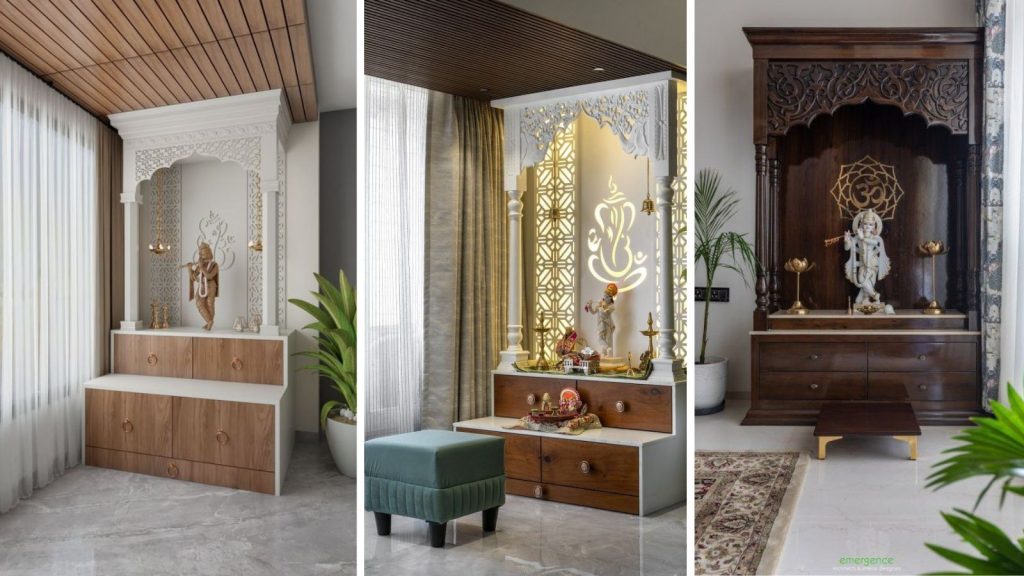
- Mandir units with built-in storage are lifesavers for everyday worship. They seamlessly store incense, prayer books, diya wicks, and more in drawers or cabinets. You’ll find everything right where you need it.
- These units come in various formats: glossy wall-mounted mandirs with hidden pull-out drawers to full-height freestanding cabinets topped with temple facades. They cater to different space constraints and aesthetic tastes.
- If you love a clean look, opt for mandirs with recessed or soft-push doors.
- Multi-level storage is a smart feature. It delivers upper shelves for idols, mid-level drawers for everyday items, and bottom cabinets for bulkier supplies like extra cups or rangoli powders. It keeps everything organised.
- Open or glass-front cabinets have a special feature of visual lightness. You can display idols and pooja paraphernalia and keep dust at bay. When closed, they maintain a clean, sacred look without hiding the spiritual elements.
- Many modern units include thoughtful touches like LED lighting within drawers or backlit panels for idols. This elevates your ritual ambiance while making night-time prayers easier.
10. Pooja Unit Under Staircase
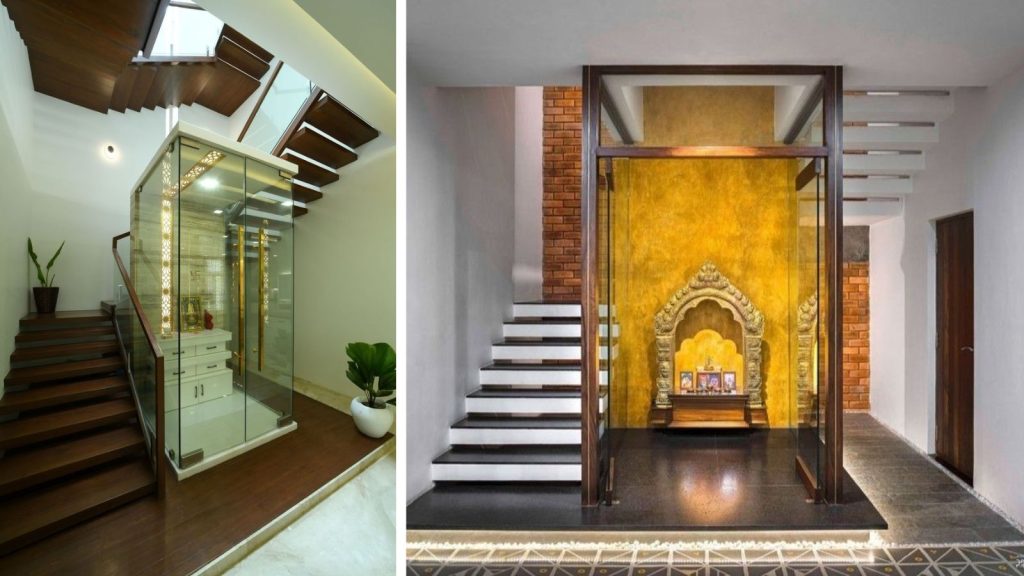
- Turning the space under your staircase into a pooja unit is pure design genius. It utilizes often-overlooked real estate and transforms it into a serene sanctuary.
- These custom-fit mandirs can be fabricated in wood or marble with a small platform for idols and lamps. They are perfectly scaled to match your stair slope.
- Lighting is crucial here. You can install soft LED strips under shelves or accent sconces to brighten the space. A softly lit shrine feels welcoming and peaceful even without windows.
- Smart storage can hide away essentials, incense, prayer books, diya plates within neat cabinets or drawers below the mandir setup. It’s functional and stylish, and keeps the tucked-away corner orderly.
- A mirror or light-coloured back panel is to visually expand the nook, small indoor plant like Tulsi for freshness, or a patterned wallpaper that increases warmth and sacred aura.
- Vastu-wise, this setup works best if the entrance faces north or east. You should ensure comfy headroom so you don’t feel cramped, and keep the area dust-free and well-ventilated to maintain positive energy.
11. Pooja Unit in Bedroom
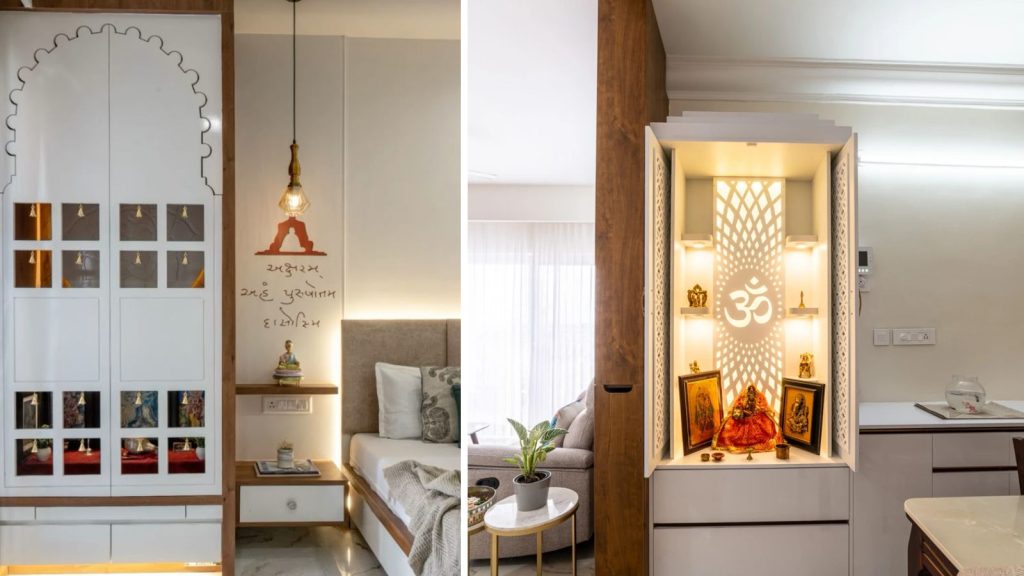
- Positioning a pooja unit in the bedroom can be surprisingly soothing, especially when positioned in a quiet, private corner like the northeast or east wall.
- Since space is often shared with sleeping areas, a compact, wall-mounted or shelf-style mandir is ideal. It frees up floor space and keeps your bedroom clean-swept and tranquil.
- A bedroom pooja unit works amazingly when the decor coordinates. Neutral palettes like pale yellow or soft blue, plus integrated backlighting that gently highlights idols, and doesn’t disrupt restfulness.
- Storage solutions matter more than ever in a bedroom. A mandir with hidden drawers or a bottom cabinet is perfect for stowing away incense, matchboxes, and prayer books, eventually keeping the space neat.
- Vastu considerations become simpler with a bedroom unit. You can angle the mandir in a manner so idols face east or west, and your bed doesn’t directly point to it. That respects tradition and keeps the room functional.
- You should install soft lighting and floating lights behind jaali panels, or sconces focused on your pooja area. It creates a calming, restful ambiance perfect for both prayer and relaxation.
12. Mandir Position in Living Room
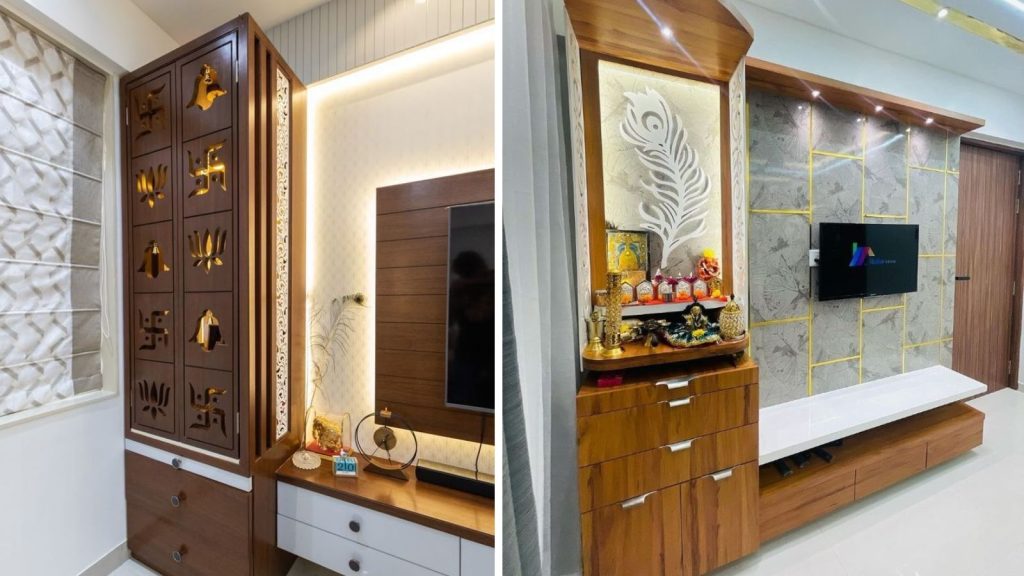
- Vastu recommends positioning your mandir in the northeast corner of the living room for maximum positive energy. If that isn’t possible, the east or north corners are good alternatives.
- Your idols should face east or west, while you pray from the opposite direction. Many follow a setup where the back of the idols faces northeast, so worshippers face northeast during prayer.
- Keep the mandir on a slightly elevated platform, around chest height (2–3 feet), rather than on the floor, which shows respect and is more comfortable for rituals.
- You should make sure there’s space around the mandir, at least 6–12 inches from walls or furniture. This barrier makes upkeep easier and symbolically keeps the energy flow unblocked.
- Avoid placing your mandir under the staircase, above sinks, or near bathrooms. These areas are considered sources of negative energy and can disrupt spiritual vibrations.
- Use soft, warm lighting (like LEDs or lamps) and keep a clean, clutter-free zone. A tidy, softly lit mandir backdrop enhances serenity and keeps the space inviting.
13. Multipurpose Pooja Stand
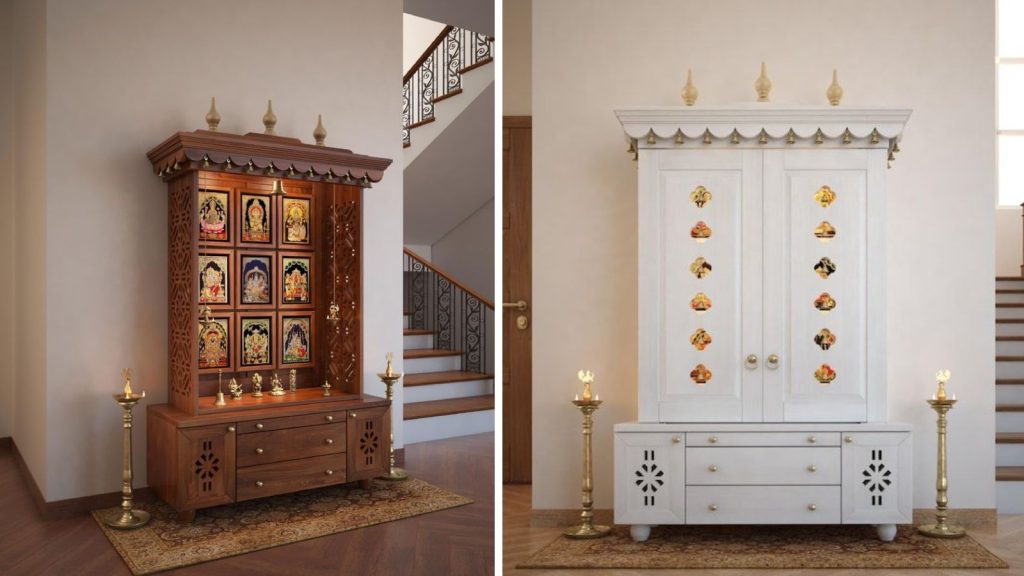
- Multipurpose pooja stands cleverly combine worship and storage. Many features like built-in drawers or hooks to hold incense sticks, bells, or small diyas. They keep everything handy yet neatly organised.
- They’re designed to fit any corner ranging from wall-mounted shelves to tabletop shrines, which makes them perfect for homes where space is precious but devotion is non-negotiable.
- Multipurpose stands can match everything to begin with traditional interiors to minimalist decors, when they are designed in diverse materials like teak wood, engineered wood with jaali inlay, brass chowkis, and even sturdy steel or acrylic.
- Some stylish units offer versatility for festivals or rituals. You can take them to balconies, roof spaces, or even outdoor areas. Foldable or lightweight stands are a boon during Navratri or Diwali.
- A sophisticated wall-mounted multi-purpose unit with a floating shelf and lower drawer keeps rituals seamless. Light idols go on top, essentials slide into the drawer, and the whole setup stays understated yet purposeful.
- Many multipurpose designs double as decorative furniture. Some feature brass hooks for hanging bells, or beautifully etched platforms. These act as incense holders or showcase trays. They elevate your pooja area while staying fully functional.
14. Compact Pooja Room Designs
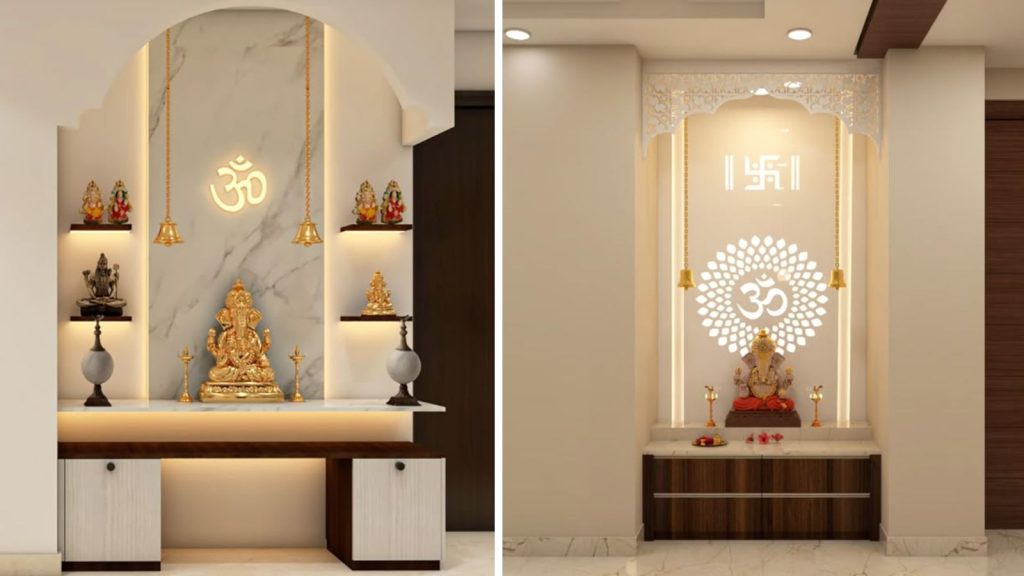
- Wall-mounted mandirs tend to offer a polished, organised, and space-saving solution. They free up floor area and can include shelves or drawers to keep diyas, incense, and prayer books neatly organised.
- They create a peaceful charm by turning an empty corner into a pooja nook. You can use a floating shelf or a corner cabinet. There is no need for a full room, yet the area feels designated and sacred.
- Niches and alcoves are goldmines for compact mandirs. You can add a backlit panel, textured wallpaper, or soft LED strips to visually separate the space and draw attention.
- Foldable or sliding doors deliver privacy and they don’t even eat up space. These clever units can be closed after pooja, while maintaining a clean and seamless apartment feel.
- Mirrors and light color palettes (white, cream, or pale pastels) make your pooja corner feel larger. In fact, a simple mirror backdrop can double the perceived space and brighten the area.
- Natural elements (wood, stone, indoor plants) bring calm and warmth. A small Tulsi plant or peace lily can purify the air and enhance the spiritual aura.
- Like sector-friendly storage ottomans, under-bench drawers, or compact cabinets, doubling consoles the interior of a living room. They all balance utility and serenity at once.
15. Mandir Designs for Flat
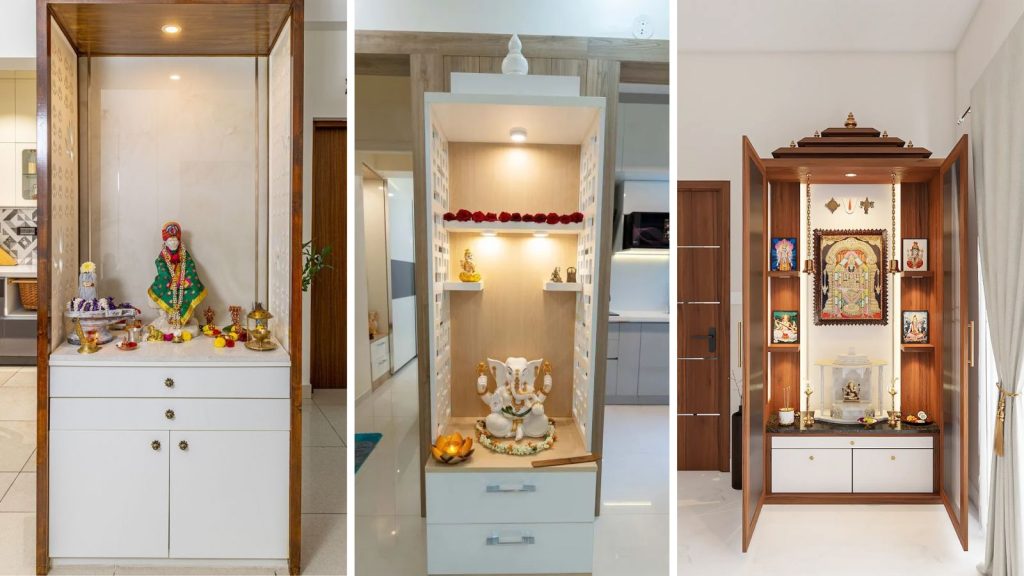
- We all know that flats often have limited square footage, so wall-mounted mandirs are a brilliant pick. These floating units free up floor space, and also offer shelves and small drawers for pooja essentials.
- An unused corner can be turned into a useful spiritual space with the help of a corner mandir. These triangular or L-shaped setups usually include built-in platforms and backlit panels. And this makes the pooja area feel sacred.
- Glass panels or translucent backdrops give a light, airy feel to your mandir. They are perfect for small flats.
- Portable or stand-alone units are especially handy if you rent or frequently shift homes. These compact mandirs can be moved around or tucked in a corner, with foldable doors for added privacy.
- Compact niches and alcoves can be transformed into elegant mandirs. Even the tiniest recessed wall space becomes a purposeful pooja area with the right lighting, wallpaper, or textured backdrop.
- You can bring out the best in a compact pooja space by opting for floating shelf mandirs, since they’re positioned thoughtfully at eye-level.
16. Mandir Unit in Living Room
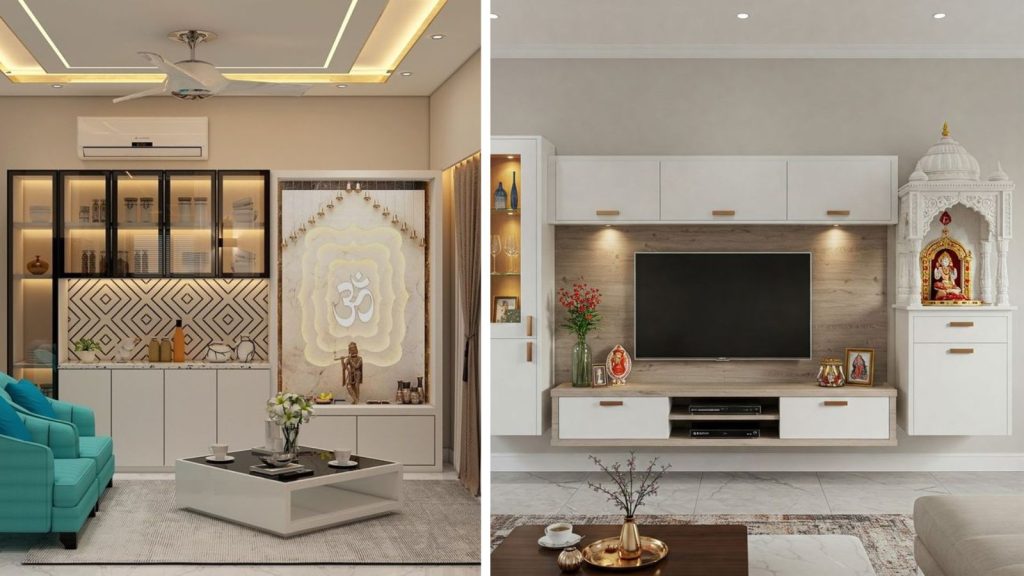
- So many homeowners tend to choose the northeast corner of the living room for their mandir unit. It is considered the most auspicious area according to Vastu. If that’s not feasible, you just aim for the east or north. They still offer positive vibes all around.
- We all seek to bring respect and comfort so that they make all the rituals all serene. To achieve it, you can resort to elevating the mandir around the chest height using a shelf or planter.
- If you’re looking for a clean and light look, you can go for glass-encased or open units with backlit wooden or marble panels. They add depth and brightness, and keep the sanctity intact.
- There is an idea of clever integration. You can combine your TV unit with the mandir. A glass-fronted niche beside or above the screen balances technology and tradition, which render visual harmony and functional use of wall space.
- You must leave at least 6–12 inches around the mandir from walls and furniture. This helps with cleaning, energy flow, and prevents clutter crowding.
- No doubt, lighting sets the mood, and it’s the most essential part of mandir decor. Soft LEDs, warm sconces, or hidden backlighting behind jaali panels form a peaceful glow. This way your mandir becomes a calming focal point in a busy living room.
17. Small Pooja Rooms for Home
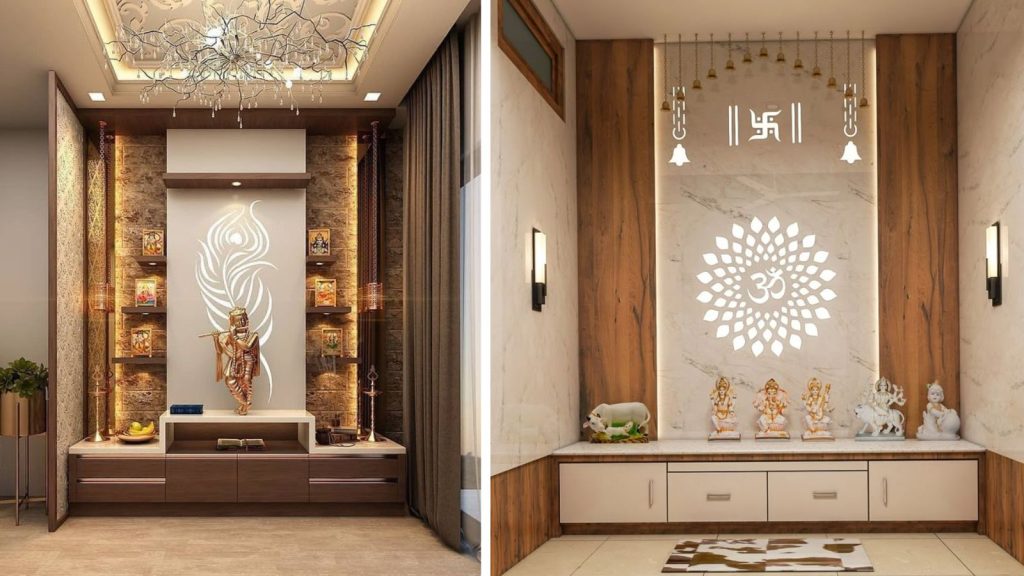
- A wall-mounted mandir is perfect for small homes. It saves floor space and can be complemented with built-in shelves or drawers to neatly store diyas, incense, and prayer books.
- You can go for converting an empty corner into a pooja nook. Because it works wonders in apartments. A corner unit (triangular or L-shaped) often includes a backlit panel or shelf, which makes the space feel special. It saves space too.
- You can instantly create a spiritual zone only by adding a floating shelf or carving a recess. Backlighting and textured wallpaper can intensify the ambiance as well.
- Mirrors behind the mandir are meant to reflect light and visually expand the space. This way even the smallest area feels open and airy. Try adding a light color palette (white, cream, pastel) for extra brightness.
- Sliding or foldable doors, including jali panels or frosted glass, deliver privacy and neatness. Therefore, you don’t need space for swinging doors. This gives your pooja corner a polished, integrated appearance.
- Multipurpose furniture, like a cabinet that doubles as a pooja mandir, makes it more convenient and purposeful. You can close doors post-rituals, hide clutter, and use the same piece as part of your living-room decor too.
18. Pooja Room Tiles
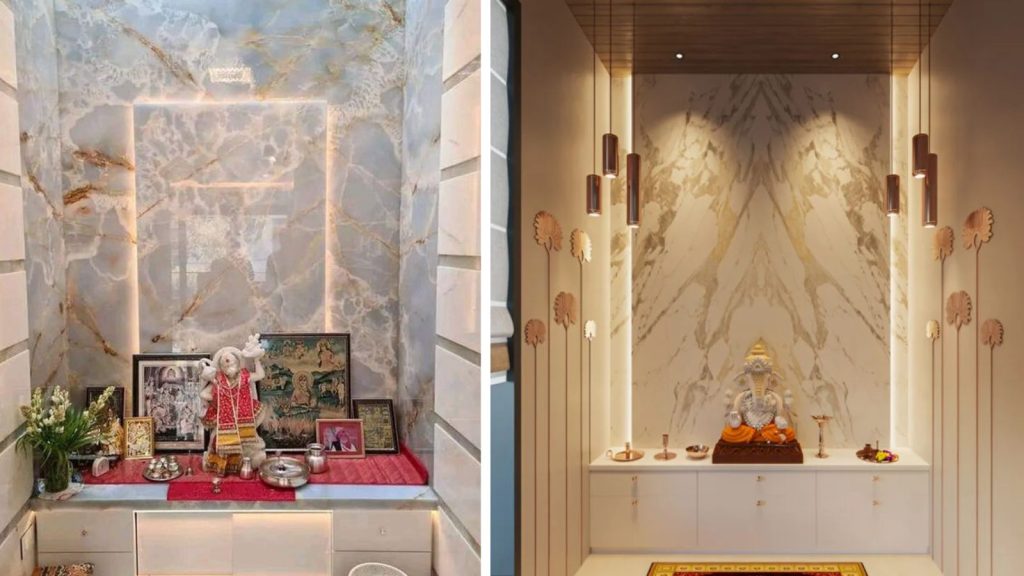
- Ceramic tiles featuring traditional Indian motifs, like lotus, mandala, Om, or Swastik, at once bring cultural richness and spiritual charm to the pooja area. They’re radiant, symbolic, and quite budget-friendly too.
- Marble or marble-effect tiles (in white, cream, or light neutrals) introduce elegance. They give a serene, sacred look and are very easy to clean. They are ideal for those who prefer a calm and uncluttered atmosphere.
- Natural stone tiles, that is, slate, granite, or limestone. They lend a grounded, earthy character. They develop a warm and rustic pooja environment, perfect for the meditative feel.
- Textured 3D or layered tiles come with visual interest, especially as a backdrop behind your idols. Their tactile surfaces catch light beautifully, but note that they may require careful cleaning.
- Wooden-look porcelain or vitrified tiles strike a perfect balance. They supply warmth, and you don’t need to maintain the issues of real wood. They’re also durable, easy to maintain, and slip-resistant.
- Terracotta or earthy-hued ceramic tiles render a rustic and grounded feel with minimal upkeep. Their rich tones pair beautifully with wooden mandirs and leafy indoor plants.
19. Pooja Mandir Designs for Walls
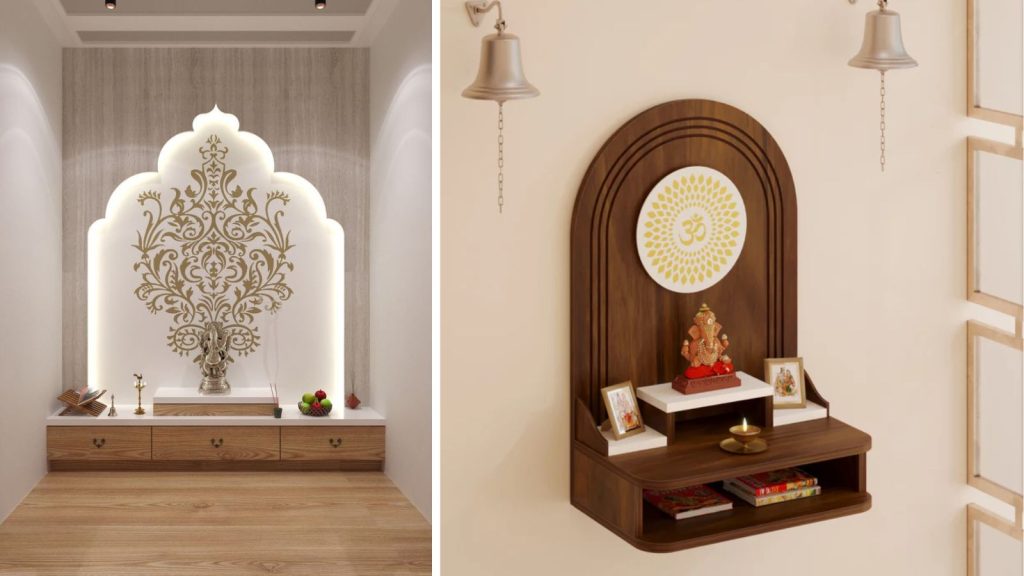
- Wall-hung pooja units are a top choice for homes with limited space. They free your floor and you get a clean, spiritual corner using only the wall. Here, designs stretch from minimal floating shelves to ornate wooden frames, that too with storage.
- Backlit mandirs bring instant ambiance and drama. Either it’s LED strips behind a mural or halo lighting around a circular niche, these lights give your pooja space a tranquil glow.
- A little wallpaper or mosaic feature panel plus statue on a floating shelf makes for a striking yet understated pooja zone.
- Jaali shutters or lattice screens with doors are there for privacy and visual flair. They filter light with expertise, hint at the space behind them, and provide a subtle way to close off the mandir post-prayers.
- Arch-style or temple-inspired mandirs on walls reflect traditional aesthetics in a modern package. Like carved arches, temple silhouettes, or Gopuram outlines, these elements introduce never-dying artistry into contemporary homes.
- If you want functionality to have an upper hand, you must go for wall mandirs with sophisticated built-in storage with hidden drawers or lower cabinets. They keep incense, matchboxes, prayer books more neatly organised.
20. Pooja Room Direction as per Vastu
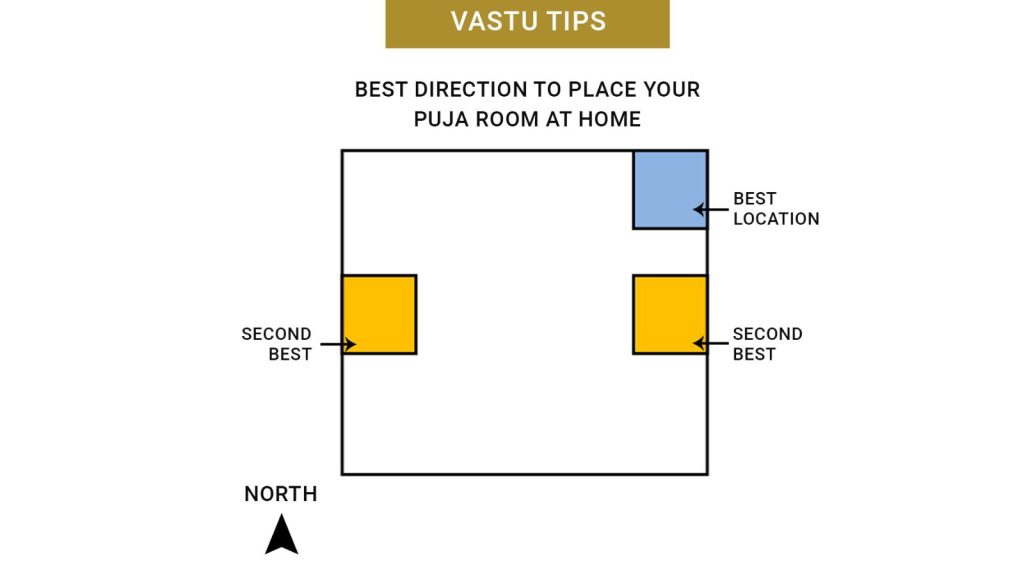
- From the viewpoint of the ancient Indian science of architecture, the northeast direction is considered the most ideal for a pooja room. It’s believed to bring in divine energy and spiritual clarity. If northeast isn’t available, go for the east or north directions instead.
- While praying, it’s best to face east or north. This is believed to align your energy with natural elements. Ideally, the deity’s idols should face west or east, so the devotee faces east or north while praying.
- Avoid placing the pooja room under staircases, directly above or below toilets, or on walls shared with bathrooms or bedrooms. These placements are considered inauspicious and can disturb the sanctity of the space.
- It’s best to keep the pooja room on the ground floor. According to Vastu, upper floors and basements don’t carry the same kind of positive energy, especially for daily rituals.
- If your mandir has doors or windows, they should ideally open toward the north or east. A double-door wooden shutter or even a jaali-style screen works well to maintain sanctity while letting in air and light.
- Idols should be placed slightly away from the wall, not directly touching it. Lamps or diyas should ideally be placed in the southeast corner of the pooja space, and if possible, opt for a pyramid-shaped ceiling to enhance the spiritual vibrations.
How Can Opalspace Help You?
Opalspace believes that a home should display one’s spirit with the chosen decor style. No matter if it’s a thoughtfully placed pooja mandir or a fully customised interior, we’re here to help you design spaces that feel balanced, intentional, and deeply personal.
As a modern interior design company, we bring together smart space planning, Vastu-informed layouts, and aesthetic detailing. Our services fall anywhere from pooja corners and storage units to living rooms, kitchens, and balconies, and more. Design we fashion and work on, is rooted in your needs and lifestyle along with the trends.
So, whether you’re starting from scratch or upgrading a specific space, Opalspace is here to make your home look home and feel right. Let’s design something evergreen and exemplary together.
As a modern interior design company, we bring together smart space planning, Vastu-informed layouts, and aesthetic detailing. Our services fall anywhere from pooja corners and storage units to living rooms, kitchens, and balconies, and more. Design we fashion and work on, is rooted in your needs and lifestyle along with the trends.
So, whether you’re starting from scratch or upgrading a specific space, Opalspace is here to make your home look home and feel right. Let’s design something evergreen and exemplary together.
FAQs
1. We live in a flat with limited space. What are some effective ideas for incorporating a mandir design for home without it feeling cramped?
For a compact home, a wall-mounted pooja mandir with doors is an excellent space-saving solution as it doesn't occupy any floor space. Another great option is a corner mandir design, which utilizes an often-overlooked area efficiently. If you need flexibility, a portable pooja unit can be placed on a console table and moved as needed. The key is to choose a design with a streamlined profile and perhaps a mirrored back panel to create a sense of depth, making the area feel more open.
2. What is the ideal position for a mandir in the living room according to common principles?
While specific beliefs can vary, a common guideline for mandir position in the living room is to choose the north-east or east wall. Placing it here is thought to allow positive energy to flow freely throughout the home. It's also generally recommended to ensure the mandir is in a clean, elevated spot and that you face east or north while praying. The most important aspect, however, is to place it where it feels respectful and allows for a quiet, focused moment of prayer.
3. I love the traditional look. What are the benefits of choosing a solid wooden temple for home?
A wooden mandir design for home brings a natural warmth and timeless elegance that is hard to replicate. Solid wood is a durable material that can feature beautiful hand-carved details or simpler, cleaner lines for a more contemporary take. Beyond its aesthetics, wood is considered an auspicious material that creates a serene and grounding atmosphere, making it a perennial favorite for a dedicated pooja space.
4. Our new home has an unused area under the staircase. Would this be a suitable location for a pooja unit?
An area under the staircase can be transformed into a wonderfully cozy and efficient pooja unit. This is a smart way to utilize what is often dead space. You can design a built-in niche with dedicated lighting, shelving, and a beautiful door frame. It’s important to ensure the height is comfortable for daily rituals and that you incorporate adequate ventilation and lighting to keep the space feeling fresh and inviting.
5. We are designing a custom pooja room and are unsure about the doors. What should we consider for the pooja mandir glass door design?
The doors of your mandir are a key feature. Glass doors, especially those with frosted or textured finishes, are popular because they allow light to filter through, offering a glimpse of the deities while protecting the space from dust. A jaali mandir design, with intricate laser-cut patterns in wood or metal, is another beautiful option that provides ventilation and a classic look. Your choice should balance aesthetics, the level of enclosure you prefer, and how much maintenance you are comfortable with, as glass will show smudges more easily.
6. For a modern home, what does a latest design pooja unit look like?
Latest designs for pooja units often lean towards a minimalist and integrated approach. Instead of a free-standing temple, you might see a sleek, wall-mounted unit with clean geometric lines, perhaps finished in a combination of wood and laminate. These designs frequently incorporate hidden storage within the unit itself to keep the area tidy. The use of indirect LED lighting is also a hallmark of modern pooja room interior design, as it creates a soft glow that highlights the deities without being harsh.
7. We need some storage for our prayer items. Are there mandir units that include practical storage?
Yes, many contemporary mandir units are designed with storage specifically in mind. A common feature is a base cabinet or drawers built directly into the structure of a standing pooja unit. This provides a discreet place to store items like puja utensils, religious books, incense sticks, and ceremonial items, ensuring the main platform remains clean and uncluttered. This integrated approach helps maintain the sacredness of the space while offering everyday practicality.
8. What kind of tiles are recommended for the pooja room to create a serene and clean backdrop?
For pooja room tiles, it's best to choose materials and colors that promote a calm and pure ambiance. Matte-finish tiles in light, neutral colors like white, off-white, light grey, or soft beige are excellent choices as they are soothing to the eye and don't show dust easily. Natural stone look-alike tiles, such as marble or sandstone, are also popular for their elegant and timeless appeal. It's generally advisable to avoid very dark or overly busy patterns that might distract from the focal point of the mandir.







